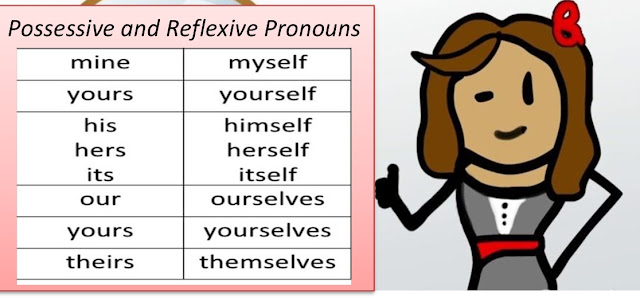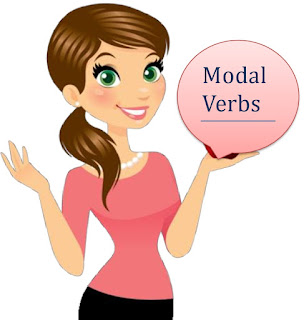Lesson Plan of Possessive and Reflexive Pronouns English Grade VII
Lesson Plan of Possessive and Reflexive Pronouns
English Grade VII
Students’ Learning Outcomes
·
Recognize function of, and
use possessive and reflexive pronouns.
Information for Teacher
Possessive Pronouns:
·
Certain pronouns called
possessive pronouns show ownership.
·
Some are used alone; some
describe a noun.
·
Used alone: mine, yours, his,
her, ours, theirs, and whose.
For example:
That computer is hers.
This is mine book.
Whose is this bike?
·
Modify nouns: my, your, his,
her, its, our, their and whose.
For example:
That is her computer.
Reflexive Pronouns:
·
Reflexive pronouns are
recognized by the addition of ‘self’ to the pronoun.
·
They are used in situations
where the subject and object is the same person.
·
He hurt himself while playing
hockey.
·
They took the responsibility
on themselves.
Reflexive Pronouns:
·
Reflexive Pronouns are used
after ‘by’ to show that the work was done without any help. So they are also
called Emphatic Pronouns.
For example;
I myself baked the cake.
The cake was backed by me.
(The number pronoun must
agree with the personal pronoun)
Concept Map
Material / Resources
Charts, marker, board, duster, flashcards,
textbook
Worm up activity
·
What is a pronoun?
(Expected response: A word
that is used in place of a noun is called a pronoun)
·
How many types of pronoun do
you remember?
(Expected response: Personal,
possessive, reflexive, subject, object, interrogative pronoun, intensive
pronoun, indefinite pronoun, demonstrative pronoun, relative pronoun,
reciprocal pronoun, and distributive pronoun)
·
Recall your knowledge about
possessive nouns (Expressing that something belongs to someone/something).
·
Also recap the use of the
Apostrophe (‘) to show possession.
·
Introduce the term Possessive
Pronouns to the students.
·
Tell them that a possessive
pronoun shows that something belongs to the pronoun(the noun has been replaced
by a pronoun)
For example:
1.
The girl’s shoes = Her shoes
2.
The dog’s collar = Its collar
Development
Activity 1
·
Complete the sentences using
the correct possessive pronouns:
1.
I entered _________ painting
in the contest. (My, Mine)
2. Selma entered ______ painting
in the contest. (Her, Him)
3.
Did you enter ______ painting
in the contest? (Your, Mine)
4.
One painting has fallen off
______ stand. (Its, Their)
5.
The judges made ________
choices. (Their, His)
6.
The car belongs to Mr. and
Mrs. Sadie, so it is _____. (Theirs, there’s)
7.
This Xbox game belongs to me
and my brother, so it is ____ . (Ours, Theirs)
8.
It belongs to him, so it is
_____. (His, Her)
9.
It belongs to you, so it’s
_____. (Yours, Theirs)
10.
It belongs to the dog, so
it’s _____. (Its, Hers)
Answer key:
1.
My, 2. Her, 3. Yours, 4. Its,
5. Their, 6. Theirs, 7. Ours, 8. His, 9. Yours, 10. Its
·
Note that the punctuation
requirements change in the possessive nouns and possessive pronouns.
·
An apostrophe must be used
with a possessive pronoun.
·
incorrect : her’s,
it’s, their’s and
your’s
·
if an apostrophe isn’t added
to a noun it will become a plural e.g. girl = girls whereas it should be girl’s
Activity 2
·
Underline the possessive
pronoun in the following sentences:
1.
Your report will be different
from mine.
2.
Their garden is bigger than ours.
3.
My book was borrowed by her sister.
Answer key:
1.
Your report will be different from mine.
2.
Their garden is bigger than ours.
3.
My book was borrowed by her sister.
Activity 3
·
Use the textbook to pick out
sentences from the passages to further understand the usage of the taught
concept:
1.
Ask a student to make a
sentence using a pronoun.
2.
Ask another student to change
the sentence by adding a reflexive pronoun.
3.
Change the sentence from
singular to plural and plural to singular.
Activity 4
·
Explain reference pronouns to
the students.
·
Ask the students to correct
the following sentences by using the correct reflexive pronoun.
1.
We arranged myself in a
group.
2.
He washed his cloths herself.
3.
She saw myself in the mirror.
Answer key:
1.
ourselves
2.
himself
3.
Herself.
Activity 5
·
Use the reflexive pronouns
from the box to complete the sentences. Then underline the person, people, or
noun to which the pronoun is referring.
Word Bank
Myself, yourself, himself, itself, ourselves,
yourselves, themselves
1. Almach and Abram did the
project all by _________________.
2.
I wondered about that
__________________.
3. Almach hurt _________________
playing hockey.
4.
The computer will turn
____________ off when it isn’t being used.
5.
Make sure you clean
_____________ up before the party starts.
6.
Jamal dusted _____________
off before he go back on the horse.
7.
You and I have to ask
________________ that question.
8.
Do you boys think you can
handle this ______?
Answer key:
1.
Themselves
2.
myself
3.
himself
4.
itself
5.
yourself
6.
himself
7.
ourselves
8.
yourselves
Sum up / Conclusion
·
Conclude the lesson by
repeating all the main points of the lesson.
Assessment
·
Ask the students the
following questions:
1.
Write five sentences using possessive
pronouns: mine, hers, and ours.
2.
What is the difference
between nouns and pronouns?
3.
Why must you replace a noun
with a pronoun?
4.
How will the use of a
reflexive pronoun change the meaning of a sentence?
Follow up
·
Ask the student s to search
five sentences from their textbooks which have reflexive pronouns and write
them in their notebooks and then change their pronouns.





Genuinely Gainful article published by you. Nice presentation and teaching I really enjoyed it. I found the advice in this article on Simple compound and complex sentences both practical and well presented. Thanks for sharing your knowledge and wisdom!
ReplyDeleteMucho texto
ReplyDelete